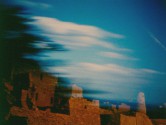
Stan Brakhage's Metaphors On Vision
Imagine an eye unruled by man-made laws of perspective, an eye unprejudiced by compositional logic, an eye which does not respond to the name of everything but which must know each object encountered in life through an adventure of perception. How many colors are there in a field of grass to the crawling baby unaware of "Green"? How many rainbows can light create for the untutored eye? How aware of variations in heat waves can that eye be? Imagine a world alive with incomprehensible objects and shimmering with an endless variety of movement and innumerable gradations of color. Imagine a world before the beginning was the word.
So begins the classic Metaphors on Vision by Stan Brakhage (1933 - 2003). First published in 1963 by Jonas Mekas as a special issue of Film Culture, it stands as the major theoretical statement by one of avant-garde cinema’s most influential figures, a treatise on mythopoeia and the nature of visual experience written in a style as idiosyncratic as his art. By turns lyrical, technical, and philosophical, this is a collection to be shelved alongside the commentaries of Robert Bresson and Maya Deren, Sergei Eisenstein and Nagisa Oshima. Yet despite its historical importance and undeniable influence, the complete Metaphors has remained out of print in the US for over forty years.
In conjunction with the republication of a new, definitive edition Metaphors on Vision by Anthology Film Archives and Light Industry, the Harvard Film Archive joins an ongoing series of Brakhage screenings that will take place at cinemas, festivals, and museums across the globe from September 2017 to February 2018.
Here is Metaphors on Vision: it is a collection of writings on the film and, in particular, on the film as Stan Brakhage sees and makes it. Yet more significantly it is a testament of what makes mythopoeic art. Mythopoeia is the often attempted and seldom achieved result of making a myth new or making a new myth.
When Brakhage began to write Metaphors, he had made some fifteen films. Most of them (from Interim in 1952 to Flesh of Morning in 1956) were in the part-neo-realist-and-part-dream-vision "psycho-dramatical" genre. Since then they have become classics to young film-makers continuing that tradition; but by 1958 (the year of his marriage) Brakhage had begun to move toward mythopoeia. He was feeling the limitations of dramatic form and sensing that film could do more than reveal the personality of an actor/subject. Simultaneous to this was the making of Anticipation of the Night, the first American film about and structured by the nature of the seeing experience; how one encounters a sight, how it is recalled, how it affects later vision, and where it leads the visionary. By making the film he came upon a simple but startling discovery which is central to his aesthetic: if vision is the highest value of film, then the camera (andits man) must allow visions to occur rather than force them (by script) upon subjects. The depth of his conviction in regard to this principle and the rejection of Anticipation by many avant-garde artists and critics previously well-disposed towards his work inspired Brakhage to formulate an Apologia by way of Metaphors on Vision.
In the three or four years of composing the five initial chapters Brakhage's writing grew from polemics to a method of clarifying his discoveries in film-making and freeing himself "thru writing" to make new ones. About fifteen more films were made during the making of Metaphors on Vision. Among them were the Prelude and Part I of his magnum opus Dog Star Man.
In the period between finishing the first five chapters and writing "Margin Alien" Brakhage had made himself, and thus his work, open to incorporate the literary traditions referred to in that latter chapter. In so doing without ever letting allusion interfere with vision he made "Dog Star Man" a truly mythopoeic film. During this time he came to accept and rejoice in the humble position of the artist as Plato sees him in Ion; that is, as one link in a chain connecting the Muse and the final audience. Brakhage became a mentor to young film-makers and a co-inspiring contemporary to artists in his own and other media. Just as his personality and work inspired a freeing process, and indeed works, in others, he was able to further his own development in answer to their letters and talks. Thus "Respond Dance" an amalgam of recent letters of his edited to be read as a single run-on statement, represents his stage of creative development and the state of his mythopoeia at the time "Metaphors" was finished.
The Harvard Film Archive presents the first of two programs celebrating the reissue of Stan Brakhage’s visionary manifesto and meditation on cinema Metaphors on Vision. Both will feature prominent filmmakers and curators who had important relationships with Brakhage, and who have been invited to curate their own individual evenings of works from the filmmaker's dauntingly vast oeuvre. This season we welcome evenings programmed and presented by filmmakers Nathaniel Dorsky and Jerome Hiler as well as celebrated curator Mark McElhatten. The celebration will be launched with a talk on Friday October 13 at 5pm with Ed Halter at the CCVA bookstore, which will have the new edition available for sale.








